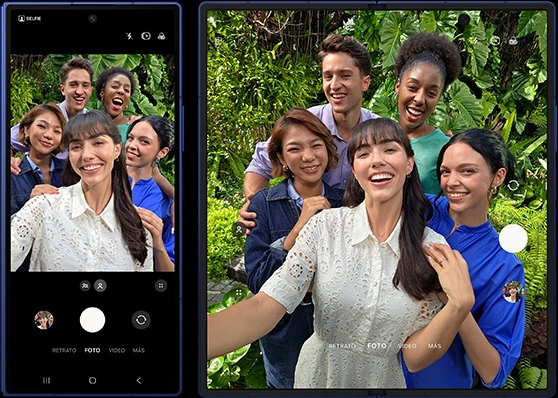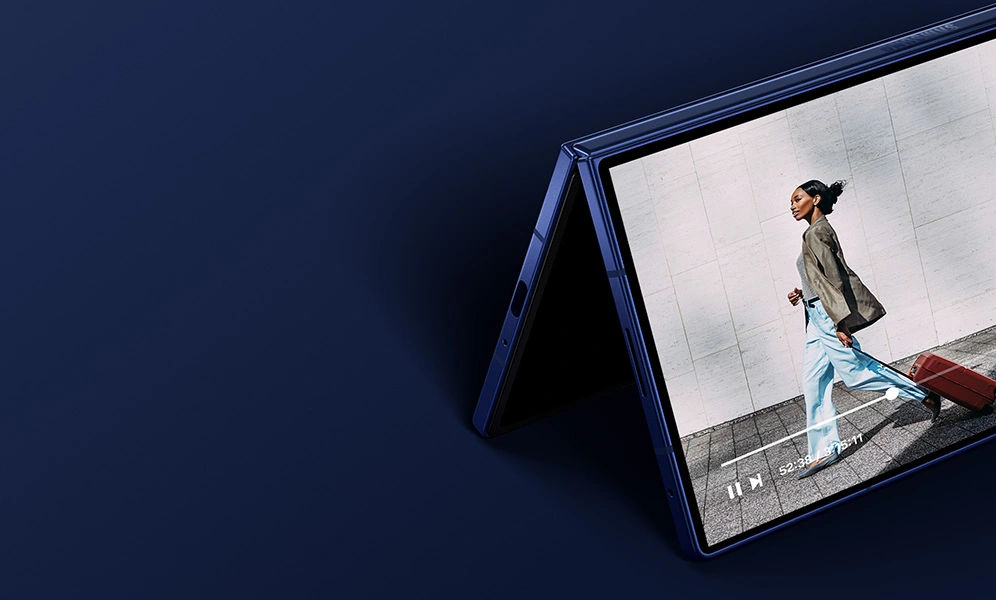The Samsung Galaxy Z Fold7 arrives as the most refined evolution of the brand’s foldable family. It’s designed for those seeking the versatility of a large screen in pocket format, but with a more comfortable design to use and hold. With a thinner body and wider external display, this model aims to deliver a more natural experience both folded and unfolded.
In our testing, we noticed Samsung didn’t just improve the hardware, but also optimized the daily experience: it now feels more like a traditional smartphone when closed, and much more productive when opened.
Design and Build — Thinner, Tougher, and More Comfortable

The Z Fold7 is the thinnest and lightest Fold to date: just 8.9mm thick when folded and 215g in weight. This makes it feel similar to a Galaxy S25 Ultra in your pocket, something unthinkable in previous generations. The new 6.5″ cover display offers a more practical width for typing and browsing without opening the device.
The chassis is made from reinforced Armor Aluminum and the Armor FlexHinge shows greater solidity, with a less visible crease. The finish conveys robustness, though the camera bump causes the device to “wobble” when placed on a flat surface.
Pros
Thinner and lighter than previous generations
Wider and more comfortable external display
Reinforced hinge and more robust design
Cons
Protruding camera module that creates instability when laid flat
If you like Samsung’s design language but don’t need a foldable, the Galaxy A54 5G offers a well-balanced mid-range experience that’s easier on the pocket.
Displays and User Experience — Better Productivity and Media
The 8″ internal Dynamic AMOLED 2X display and 6.5″ external display, both with up to 120Hz refresh rate, offer great fluidity and brightness up to 2600 nits. However, outdoors we noticed the Fold6 could achieve slightly higher brightness under intense sunlight.
The new aspect ratio of the external display allows most tasks to be performed without unfolding the phone, something that wasn’t as comfortable in previous generations. For productivity, the extra space of the internal display makes it easier to work with spreadsheets, edit documents, or even manage websites in desktop version without needing a computer.
Pros
Excellent image quality and fluidity
External display genuinely useful for daily use
Improved multitasking productivity
Cons
Maximum outdoor brightness slightly lower than Fold6
Prefer a bold design and flagship-level specs without the fold? The Motorola Edge 50 Ultra might be your kind of “ultra.”
Cameras — Jump to 200MP and Versatility Improvements

The 200MP main camera inherited from the Galaxy S25 Ultra delivers outstanding detail, accompanied by a 12MP ultra-wide with variable focus (useful for macro) and a 10MP 3x telephoto. The under-display internal camera is replaced by a visible 10MP sensor, offering much better quality for video calls.
In our testing, photos and videos showed good sharpness and balanced colors, even in low light. However, the lack of a longer-reach telephoto limits zoom compared to models like the S25 Ultra.
Pros
Ultra-high resolution main camera
Ultra-wide with macro function
Improved internal camera for video calls
Cons
Lack of optical zoom beyond 3x
Battery and Performance — Solid Battery Life and Unchanged Charging
With a 4400mAh battery, the Fold7 achieves a full day of intensive use and up to more than a day with moderate use. Fast charging remains at 25W (50% in 30 min) and maintains wireless and reverse charging.
The Snapdragon 8 Elite processor offers excellent performance for heavy tasks and gaming, though due to its thinness, heat dissipation could be challenging during extended sessions.
Pros
Sufficient battery life for a full day
High-end performance
Wireless and reverse charging
Cons
Charging speed behind some rivals
Conclusion
The Galaxy Z Fold7 is Samsung’s most mature foldable yet. The combination of a thinner design, genuinely useful external display, and improvements in camera and performance make it ideal for those wanting productivity and entertainment in a single device.
It’s not perfect, especially due to the lack of a long telephoto and faster charging. But it marks an important step toward establishing foldables as a real alternative to traditional smartphones.
Technical Specifications
| Feature | Detail |
| Dimensions (folded) | 158.4 × 72.8 × 8.9 mm |
| Dimensions (unfolded) | 158.4 × 143.2 × 4.2 mm |
| Weight | 215 g |
| Main display | 8.0″ Dynamic AMOLED 2X, 2184 × 1968, 120 Hz |
| External display | 6.5″ Dynamic AMOLED 2X, 2520 × 1080, 120 Hz |
| Peak brightness | 2600 nits |
| Processor | Snapdragon 8 Elite, octa-core up to 4.47 GHz |
| RAM | 12 GB / 16 GB (1 TB model) |
| Storage | 256 GB / 512 GB / 1 TB |
| Rear cameras | 200 MP (f/1.7) + 12 MP ultra-wide (f/2.2) + 10 MP 3x tele (f/2.4) |
| Inner front camera | 10 MP (f/2.2) |
| Cover camera | 10 MP (f/2.2) |
| Battery | 4400 mAh, 25W fast charging, 15W wireless, 4.5W reverse |
| Connectivity | 5G, Wi-Fi 7, Bluetooth 5.4, NFC, UWB |
| OS | Android 16, One UI 8.0 |
Alternatives
Google Pixel 10 Pro Fold: Premium book-style foldable with IP68 certification, 6.4″ external display with 3,000 nits brightness, 5,000+ mAh battery, and Tensor G5 chip optimized for AI.
Motorola Razr Ultra 2025: More compact flip format with 7″ internal display, 68W fast charging, triple 50MP cameras, and strong AI feature integration.
Samsung Galaxy Z Fold6: Previous generation with good external display and solid multitasking experience, ideal if you want the Fold experience at a lower price point.
